Case Study 1 – Conserve Energy by Insulating Offices!
Case Study 1 – Conserve Energy by Insulating Offices!
If you are interested in understanding how our client opted to insulate their commercial offices buildings, or if you have a similar project read below…
Introduction:
This renovation project took place in Dronfield. The property had previously been unoccupied for several years but had massive potential. The developer purchased this to convert into offices, to later be made available for rental. On the ground floor there was office space, and on the lower ground floor further office space and ancillary space. The total square footage of the building was: 2,050.
The building when purchased was greatly susceptible to heat loss, given the lack of insulation in the building. This needed to be addressed so the developer purchased insulation to cover all the Walls, Floors and the Roof. This was an initial cost; however, the developer knew insulating would be beneficial in the long term both for the benefit of those who work within the offices and financially getting a significant return.
The developer opted for the most efficient insulation solutions – considering both the costs and thermal benefits.
Is it difficult to insulate concrete and directly on to the floorboards?
No – some areas of the floor had a concrete surface and other areas had floorboards. The developer thankfully was able to use the same insulation, on both the concrete and on the floorboards.
What product was used, to insulate the floor?
The developer used a product called EcoTec Floor Foam. This floor insulation is a just 4mm thick, which made it flexible and consequently easy to fit. The insulation is made up of a dense foam. Both sides have an outer layer of a highly reflective true aluminium foil on both sides. This foil increases the thermal benefits, by allowing the heat to reflect into the room, while also reflecting the cold from beneath the floor away.
Applying EcoTec Floor Foam, directly on to the Floorboards
Most rooms had timber flooring, opposed to concrete. Where this was the case, the developer simply stapled the insulation directly on to the floor, using a Heavy-Duty Staple Gun and 14mm staples. The customer was confident that their floor insulation would stay fixed in place. Each line of EcoTec Floor Foam that was applied, was then sealed at the joints using ThermaSeal Foil Joining Tape. This was done to ensure that there was no room for energy leakage and to maximise the thermal benefits of the product. At SuperQuilt Insulation, we understand the importance of using tape, and in turn we supply a free roll of Thermaseal Foil Joining Tape, with every roll of Floor Foam you purchase.
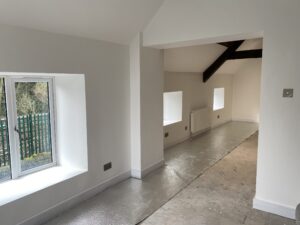
EcoTec Floor Foam, applied on either concrete or floorboards.
Installing EcoTec Floor Foam, directly on to Concrete
The developer insulated their concrete in a way, which was equally as simplistic. Here, the installer used a Non-Adhesive Glue. The glue ensured that the Insulation was fixed securely to the concrete. The Thermaseal Foil Joining Tape was again used to seal the joints, between each line of EcoTec Floor Foam.
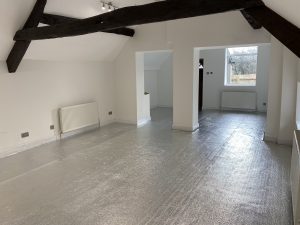
EcoTec Floor-Foam Insulation
Using SuperQuilt to Insulate Walls
SuperQuilt, which is one of the highest performing multi foils on the market and was used to insulate all the walls, throughout the duration of the project. The insulation is made up of just 19 layers and compresses to 7mm, this multi foil insulation was perfect for the project both for its thermal benefits and its space saving nature.
It is superior to other insulation materials, such as Actis, TLX Silver & SuperFoil Insulation. YBS SuperQuilt Thermal Insulation is also UK Manufactured.
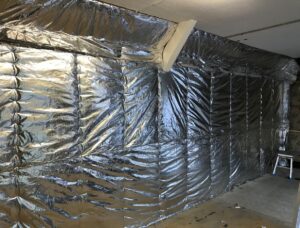
Solid Wall SuperQuilt Insulation
How our customer insulated his walls, using SuperQuilt
The developer installed 25mm Battens vertically, prior to applying a layer of the multifoil SuperQuilt Insulation. When fitting the SuperQuilt, the staples were placed at 30mm intervals to ensure the SuperQuilt stayed in place. The customer used a heavy-duty staple gun, which made the stapling process easy whilst also ensuring the insulation was secured.
To prevent any heat escaping the developer overlapped each layer of SuperQuilt by 50mm. Where the Quilt overlapped, Thermeseal Foil Joining Tape was used to again ensure that no unwanted cool air enters via the walls into a room and also to ensure that the heat inside was retained. Put simply, the tape along with the SuperQuilt works as a high performing vapour control layer.
When the walls were complete, the customer then drilled the secondary battens on top of the SuperQuilt and installed the plasterboard.
Ceiling level SuperQuilt Insulation Installation
The customer applied SuperQuilt to the roof and began the insulation process by cutting the SuperQuilt to the width of the roof. Starting from the external wall, the customer unrolled the SuperQuilt so it was perpendicular to the joists.
Timber battens held the SuperQuilt in place securely, and also left a 25mm gap / air cavity both above and below the insulation lessening the risk of thermal bridging.
Here, a Layer SuperQuilt was installed on the internal side of 200mm existing Mineral Wool / Glasswool. SuperQuilt can be used in conjunction with other insulation products for extra thermal benefits.
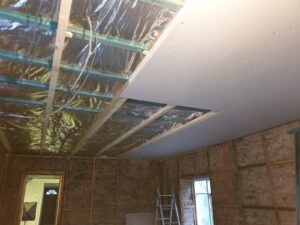
Ceiling Level Insulation – SuperQuilt
Rafter level insulation installation, using SuperQuilt
The developer installed their SuperQuilt horizontally, pulling in tort prior to stapling on to the rafters. Stapling frequently helps to ensure the SuperQuilt is securely in place – here the developed left 300mm intervals between each staple. It is ok to staple more frequently, but we would advise no less than at every 300mm.
The developer using Thermaseal Foil Joining Tape, to seal where he had overlapped the insulation by 50mm.
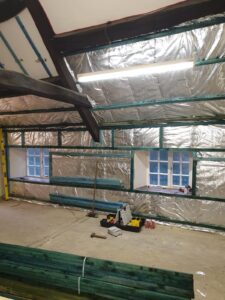
SuperQuilt Insulation at rafter level
The customer also had exposed purlins, which were they wanted to keep exposed for aesthetic purposes. In this case, the old plasterboard was already fitted in place so the customer opted to install battens between the beams, and followed by installing a complete layer of SuperQuilt (7mm Compressed).
The counter battens were then applied, prior to installing the plasterboard.
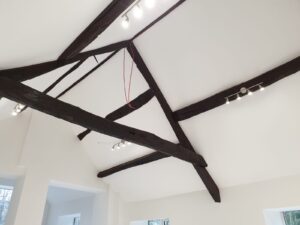
Insulating Pitched Roof with SuperQuilt, leaving beams exposed
To purchase any of the aforementioned products please press the below links, and feel free to contact us for any technical advice – we are happy to help.
Purchase the floor insulation, called EcoTec Floor Foam – HERE
Purchase a Heavy Duty Staple Gun Kit, with 5,000 14mm staples – HERE
Purchase your Thermaseal Foil Joining Tape, to seal all joints – HERE
Purchase the highest performing MultiFoil on the market, that can be used on the walls, roof and also floors – HERE. If you have a large project and require a large quantity, it may be worth purchasing a Trade Pallet Deal – HERE
If you do require any assistance achieving a U-Value to satisfy Building Control click – HERE – to receive FREE assistance.

 Fast Next Working Day Delivery
Fast Next Working Day Delivery Bulk Discounts Available
Bulk Discounts Available Order Pre 2pm for Delivery
Order Pre 2pm for Delivery 